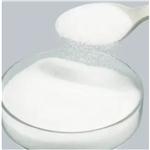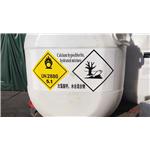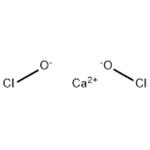- Calcium hypochlorite
-

- $1100.00 / 100Tons
-
2024-04-18
- CAS:7778-54-3
- Min. Order: 100Tons
- Purity: 99.99%
- Supply Ability: 200Tons
- Calcium hypochlorite
-

- $1.00 / 40kg/drum
-
2024-04-10
- CAS:7778-54-3
- Min. Order: 40kg/drum
- Purity: 0.65
- Supply Ability: 100
- Calcium hypochlorite
-

- $50.00 / 1KG
-
2023-12-24
- CAS:7778-54-3
- Min. Order: 1KG
- Purity: 99%
- Supply Ability: g-kg-tons, free sample is available
|
| | Calcium hypochlorite Chemical Properties |
| Melting point | 100 °C(lit.) | | density | 2.35 g/mL at 25 °C(lit.) | | storage temp. | Store at +15°C to +25°C. | | solubility | 200g/l (decomposition) | | form | Tablets | | Specific Gravity | 2.35 | | color | White to off-white or faint green | | Odor | Chlorine-like odor | | Water Solubility | 200 g/L (20 ºC) (dec.) | | Merck | 14,1674 | | Dielectric constant | 2.3(Ambient) | | Stability: | Stability Strong oxidizer - contact with flammable material may lead to fire. Incompatible with water, reducing agents, combustible material, phenol. | | InChIKey | ZKQDCIXGCQPQNV-UHFFFAOYSA-N | | CAS DataBase Reference | 7778-54-3(CAS DataBase Reference) | | EPA Substance Registry System | Calcium hypochlorite (7778-54-3) |
| | Calcium hypochlorite Usage And Synthesis |
| Description | Calcium hypochlorite (molecular formula: Ca (ClO)2) is a kind of inorganic compound. It appears as a white granular solid with chlorine odor. Though it is relatively stable and non-combustible, it will accelerate the burning of combustible materials. Sodium hypochlorite solid is generally not commercialized. Instead, it is highly soluble in water and can be formulated into various concentrations. The resulting sodium hypochlorite solutions appears as clear, green to yellow liquids. It has two major applications. One is sanitation. For this purpose, it is primarily used as bleaching agent or disinfectants to sanitize publish swimming pools as well as disinfect drinking water. It is also used in the disinfection of surfaces and equipment of kitchen and bathroom. Moreover, it can be used as algaecides, herbicide and laundry detergents. Another major application is in organic chemistry. It can act as a general oxidizing agent for the cleavage of glycols, keto acids to obtain fragmented aldehydes or carboxylic acid. It can also be used for the manufacture of chloroform. Calcium hypochlorite can be manufactured through the reaction between limes (Ca(OH)2) with chlorine gas to give various concentrations of products. Calcium hypochlorite is toxic. Its solution can emit toxic gases such as chlorine. Inhalation can lead to olfactory fatigue and irritation on the lung airway. It is also irritating to the skin and eye upon contact. Ingestion of it can cause vomiting and corrosive injury to the gastrointestinal tract. | | References | https://pubchem.ncbi.nlm.nih.gov/compound/24504#section=Top
https://en.wikipedia.org/wiki/Calcium_hypochlorite
https://www.atsdr.cdc.gov/mmg/mmg.asp?id=927&tid=192
| | Description | Calcium hypochlorite, is an oxysalt; it is a crystalline solid and an oxidizer that decomposes at 212°F (100°C). Calcium hypochlorite is a dangerous fire risk in contact with organic materials. It is also a common swimming pool chlorinator and decomposes in contact with water, releasing chlorine into the water. If a container of calcium hypochlorite becomes wet in storage, the result can be an exothermic reaction. If combustible materials are present, a fire may occur. The chlorine in the compound will be released by contact with the water and will then accelerate the combustion process. The four-digit UN identification number for dry mixtures with not less than 39% available chlorine (8.8% oxygen) is 1748; hydrated with not less than 5.5% and not more than 10% water, the number is 2880; mixtures that are dry, with not less than 10% but not more than 39% available chlorine, are numbered as 2208. The NFPA 704 designation for calcium hypochlorite is health 3, flammability 0, and reactivity 1. The white section at the bottom of the diamond has the prefix “oxy,” indicating an oxidizer. The primary uses are as a bleaching agent, a swimming pool disinfectant, a fungicide, in potable-water purification, and as a deodorant. | | Chemical Properties | Calcium hypochlorite, Ca(OCl)2.4H20, also known as calcium oxychloride, chlorinated lime, and bleach, is a deliquescent white powder used as a bleaching agent in the textile and pulp industries and as a disinfectant. It contains 60 to 65% available chlorine, | | Chemical Properties | Calcium hypochlorite is a white powder, granule, or pellets with a strong chlorine-like odor. | | Physical properties | White crystalline solid; density 2.35 g/cm3; decomposes when heated to 100°C; soluble in water and alcohol (with decomposition). | | Uses | Bleaching of wood pulp, linen, cotton, straw, oils, soaps, and in laundering; oxidizer in calico printing to obtain white designs on a colored ground; destroying caterpillars; disinfecting drinking water, sewage, etc.; as a decontaminant for mustard gas and similar substances. | | Uses | Deodorant, oxidizing agent, bleaching agentCalcium hypochlorite is used for swimming pool sanitation and other water treatment plants. It is also used to disinfect drinking water, equipments in the industry and surfaces and equipments in kitchens. Further, it is used to bleach textiles and paper. It is also employed in bathroom cleaners and laundry detergents. It is used as an oxidizing agent in organic chemistry. It is involved in the cleavage of glycols, alfa-hydroxy carboxylic acids and keto acids to yield fragmented aldehydes or carboxylic acids respectively. It plays an important role in the haloform reaction to prepare chloroform. | | Uses | Bleaching powder is actually a mixture of calcium
hypochlorite (Ca(ClO)2) and the basic chloride CaCl2,
H2O with some slaked lime, Ca(OH)2. The product is
generally called “bleaching powder”. It consists of
a mixture of calcium chloride (CaCl2), calcium hypochlorite
(Ca(OCl)2), and calcium chloride hypochlorite
(CaCl(OCl)). Ca(ClO)2 is used in industrial wastewater treatment,
sanitation and cleaning, epidemic prevention and
household sanitation facilities, as well as for disinfection
and sterilization of swimming pools, drinking water,
cleaning vegetables, and sanitizing fishponds.
Calcium hypochlorite has
been used for bleaching of cotton, hemp, fiber, pulp
and starch, disinfection of surfaces, and as a sterilant
for water treatment. It has also been proposed as a solid
fire extinguisher. | | Preparation | Calcium hypochlorite is manufactured by two main processes, the socalled
“calcium process” and the “sodium process”.
These are essentially the same as described for the
Mg(ClO)2 salt method given above except that a sodium
hypochlorite salt is used in one case and a calcium chloride
salt in the other. The products are nearly the same. Calcium hypochlorite
is manufactured by the calcium process:
2Ca(OH)2+2Cl2→Ca(ClO)2+CaCl2+2H2O
In another method developed for the manufacture of
Ca(ClO)2, chlorine gas is reacted with calcium
hydroxide:
Ca(OH)2+ 2Cl2→Ca(ClO)2+ 2HCl
In this method, it is claimed that the excess HCl is
neutralized by excess Ca(OH)2 to form CaCl2. The
product is said to be more “neutral” chemically and
more stable than that produced by other methods. | | Definition | A white solid that
can be regarded as a mixture of calcium
chlorate(I) (calcium hypochlorite), calcium
chloride, and calcium hydroxide. It is prepared
on a large scale by passing a current
of chlorine through a tilted cylinder down
which is passed calcium hydroxide. Bleaching
powder has been used for bleaching
paper pulps and fabrics and for sterilizing
water. Its bleaching power arises from the
formation, in the presence of air containing
carbon dioxide, of the oxidizing agent
chloric(I) acid (hypochlorous acid, HClO):
Ca(ClO)2.Ca(OH)2.CaCl2 + 2CO2 →
2CaCO3 + CaCl2 + 2HClO. | | Reactions | As strong oxidant, calcium
hypochlorite may react with vigor in combination with
carbon compounds, and combination with finely
divided carbon particles forms an explosive mixture.
Reaction with acetylene leads to creation of explosive
chloroacetylenes. Contact with organic matter, oil,
hydrocarbons and alcohols such as methanol or ethanol may cause a violent explosion. Reaction with
nitromethane causes a delayed violent reaction.
Organic sulfur compounds such as sulfides react by
self-ignition and explosion. Iron oxide in metal
containers catalyze oxygen-evolving decomposition of
the oxidant. | | General Description | Calcium hypochlorite, hydrated is a white granular solid or tablets compressed from the granules having an odor of chlorine. Calcium hypochlorite is noncombustible, but Calcium hypochlorite will accelerate the burning of combustible materials. Calcium hypochlorite is decomposed by water with evolution of chlorine gas and heat. Prolonged exposure to fire or heat may result in the vigorous decomposition of the material and rupture of the container. Material containing less than 39% available chlorine may undergo reactions as described above though Calcium hypochlorite may take longer to initiate, and the resulting reactions may not be as vigorous. Calcium hypochlorite is used for water purification, disinfectant for swimming pools, for bleaching paper and textiles, and for many other uses. | | Reactivity Profile | CALCIUM HYPOCHLORITE is a powerful oxidizing agent, particularly in the presence of water or at higher temperature as Calcium hypochlorite decomposes to release oxygen and chlorine gases. As strong oxidant Calcium hypochlorite may react with vigor in combination with carbon, especially finely divided is explosive; acetylene, leads to creation of explosive chloroacetylenes; organic matter, oil, hydrocarbons; alcohols may cause explosion, methanol, ethanol, etc.; nitromethane caused delayed violent reaction; organic sulfur compounds, sulfides tend toward ignition and sometimes explosion; with iron oxide in metal containers catalyze oxygen evolving decomposition of the oxidant. Calcium hypochlorite forms highly explosive NCl3 on contact with urea. Produces highly toxic gaseous chlorine gas when heated or on contact with acids [Sax, 9th ed., 1996, p. 1905]. Mixture of damp sulfur with hypochlorite caused a violent reaction, that ejected molten sulfur, Chem Eng. News, 1965, 46(29), 6. | | Hazard | Dangerous fire risk in contact with organic
materials. | | Health Hazard | Inhalation, ingestion or contact (skin, eyes) with vapors or substance may cause severe injury, burns or death. Fire may produce irritating, corrosive and/or toxic gases. Runoff from fire control or dilution water may cause pollution. | | Fire Hazard | These substances will accelerate burning when involved in a fire. Some may decompose explosively when heated or involved in a fire. May explode from heat or contamination. Some will react explosively with hydrocarbons (fuels). May ignite combustibles (wood, paper, oil, clothing, etc.). Containers may explode when heated. Runoff may create fire or explosion hazard. | | Industrial uses | Calcium hypochlorite Ca(OCl)2 can be found in swimming pool disinfectants,
in bleaching agents, in deodorants and in fungicides. | | Potential Exposure | Calcium hypochlorite is used to killalgae and bacteria, in bleach, and in pool chemicalproducts | | First aid | If this chemical gets into the eyes, remove anycontact lenses at once and irrigate immediately for at least15 min, occasionally lifting upper and lower lids. Seek medical attention immediately. If this chemical contacts the skin,remove contaminated clothing and wash immediately withsoap and water. Seek medical attention immediately. If thischemical has been inhaled, remove from exposure, begin rescue breathing (using universal precautions, including resuscitation mask) if breathing has stopped and CPR if heart actionhas stopped. Transfer promptly to a medical facility. Whenthis chemical has been swallowed, get medical attention.Give large quantities of water and induce vomiting. Do notmake an unconscious person vomit. Medical observation isrecommended for 24-48 h after breathing overexposure, aspulmonary edema may be delayed. As first aid for pulmonaryedema, a doctor or authorized paramedic may consideradministering a corticosteroid spray. | | storage | Color Code—Yellow: Reactive Hazard; Store in alocation separate from other materials, especially flammables and combustibles. Prior to working with Calciumhypochlorite you should be trained on its proper handlingand storage. Calcium hypochlorite must be stored to avoidcontact with strong acids (such as hydrochloric, sulfuric,and nitric), ammonium compounds (such as ammonia andammonium hydroxide), and amines (such as aniline) sinceviolent reactions occur. Store in tightly closed containers ina cool, well-ventilated area away from water or moistureand combustibles (such as wood, paper, or oil). Whenheated above 100℃, Calcium hypochlorite becomes explosive. Protect containers against physical damage. Avoidstorage for long periods, particularly at summer temperatures. See OSHA Standard 1910.104 and NFPA 43A Codefor the Storage of Liquid and Solid Oxidizers for detailedhandling and storage regulations. | | Shipping | UN1748 Calcium hypochlorite, dry or Calcium
hypochlorite mixtures dry with .39% available chlorine
(8.8% available oxygen), Hazard Class: 5.1; Labels: 5.1-
Oxidizer. UN2208 Calcium hypochlorite mixtures, dry,
with .10% but not .39% available chlorine, Hazard
Class: 5.1; Labels: 5.1-Oxidizer. UN2880 Calcium hypochlorite, hydrated or Calcium hypochlorite, hydrated mixtures, with not ,5.5% but not .16% water, Hazard Class:
5.1; Labels: 5.1-Oxidizer | | Incompatibilities | A powerful oxidizer. Decomposes in
heat or sunlight; becomes explosive above 100�C/212�F.
Incompatible with strong acids; water and other forms of
moisture, reducing agents; combustible materials; all other
chemicals, especially acetylene, aniline and all other
amines, anthracene, carbon tetrachloride, iron oxide, manganese oxide, mercaptans, diethylene glycol monomethyl
ether, nitromethane, organic matter; organic sulfides, phenol, 1-propanethiol, propyl mercaptan, sulfur, turpentine,
organic sulfur compounds. Attacks various metals, releasing flammable hydrogen gas. | | Waste Disposal | Dissolve the material in water
and add to a large volume of concentrated reducing agent
solution, then acidify the mixture with H2SO4. When reduction is complete, soda ash is added to make the solution
alkaline. The alkaline liquid is decanted from any sludge
produced, neutralized, and diluted before discharge to a
sewer or stream. The sludge is landfilled |
| | Calcium hypochlorite Preparation Products And Raw materials |
|